Site Links
Howdy, Stranger!
It looks like you're new here. If you want to get involved, click one of these buttons!
Quick Links
Categories
In this Discussion
Who's Online (0)
Misc project adventures
Had another thread asking/venting about measurement vs simulation. Happy to report that dropping ceramic sb 4" into the hole, which orig tried some buyout 4"/4.5 sb paper cone from PE that was driving me nuts with 3-4db drop at 1.5k that I was prob over obsessed with getting flatter measurements vs hearing, has worked out great. About ready to actually put the crossover inside the speaker, though want to test couple things to get better phase alignment. Mid-tweet XO at about 2200. Also, to refresh, satori 9.5 4ohm, sb 4" cac, sb29nd tweet - will attach pic.
But several months ago bought up someone's 'premium' Seas Loki kit. Assembled, was loving the coax effect and warmness. Later tried SB's 4" coax in poor man 'roy' type build with grs 8" sub - meh, need to readjust the stock crossover sb provides. So decided to give it a better try to make own primary speakers, although the 3 way SB mentioned above is excellent - no sub needed at all, make Seas prestige line "ROY" with 4.5" alum/silk coax and 7" titan driver. Just completed cabinet, about 0.8 cuft with 3L chamber for coax and dayton 8" alum PR on back. Can those come to PE's SDC 2024? as suspect crossover for mid-tweet end up similar to seas's recommended network though imagine reduce some of the bsc since acting as mid and additional 2nd order high pass - would feel like cheating, but will see how comes out.
Then have 2 additional projects, to learn from. One using some tang band 4" w1720's with sb26 neo tweet and 5" PR in 0.23 denovo cab and other using seas 17 poly cone and peerless alum tweet (pillaged from 2023 sdc, dat zinger tweet) in a 0.5 denovo cab to mimic the older Meridian designs (owned dsp5000's way back in mid 2000's). Those are both just to learn from, simpler 2way.
Oh, and along the way (this down time during holidays), slapped together some bass bin, stands with epique7 and css 10apr that work well but yearning more for the standalone speaker that hits to targets. Since run the epic7 bass bins with minidsp and 400wpc icepower.
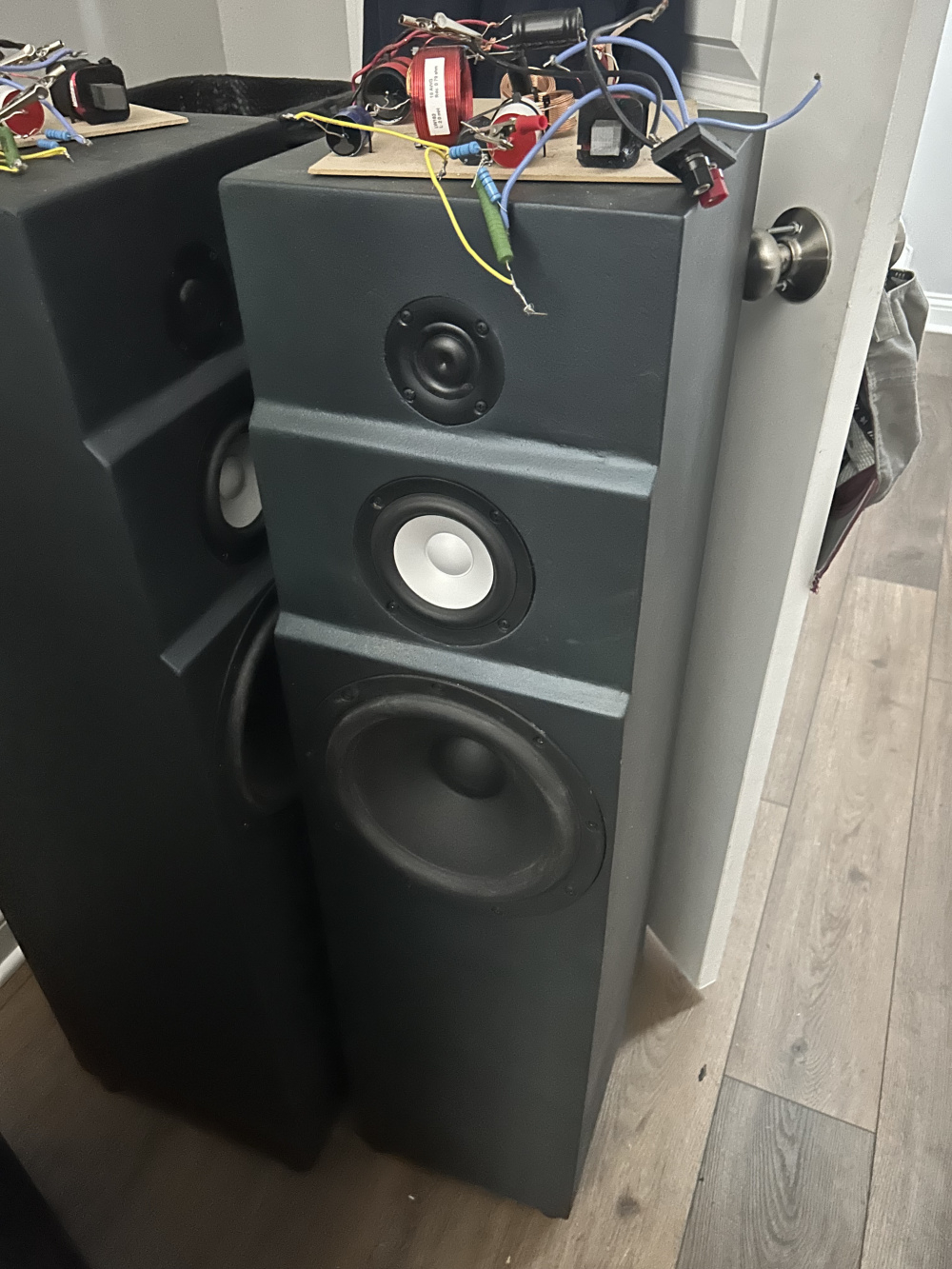
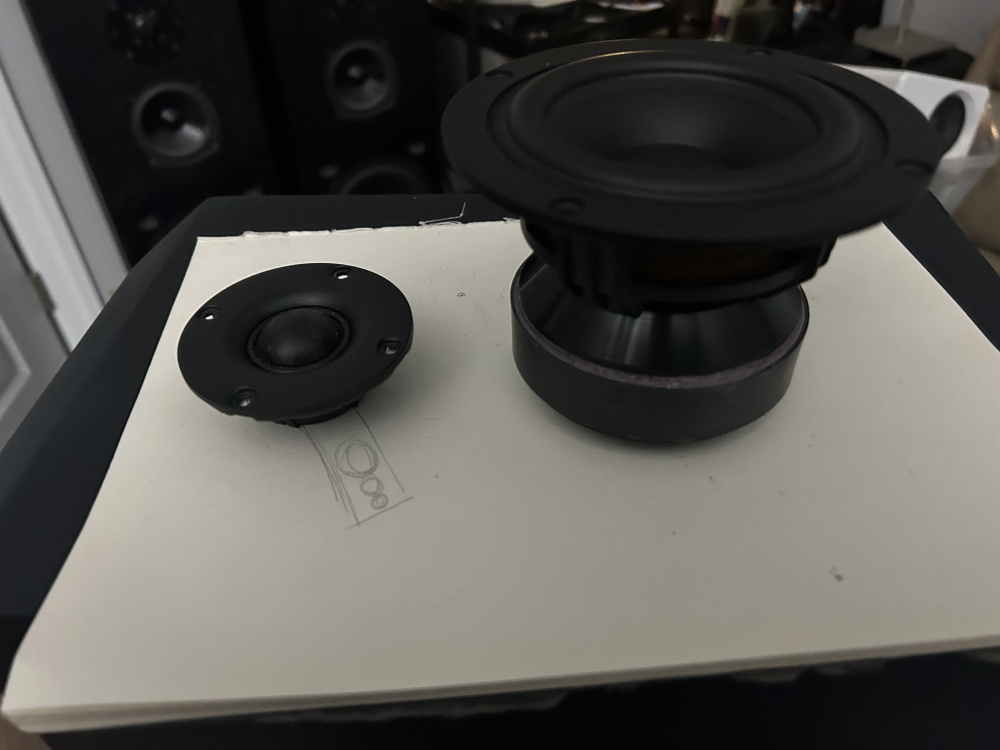
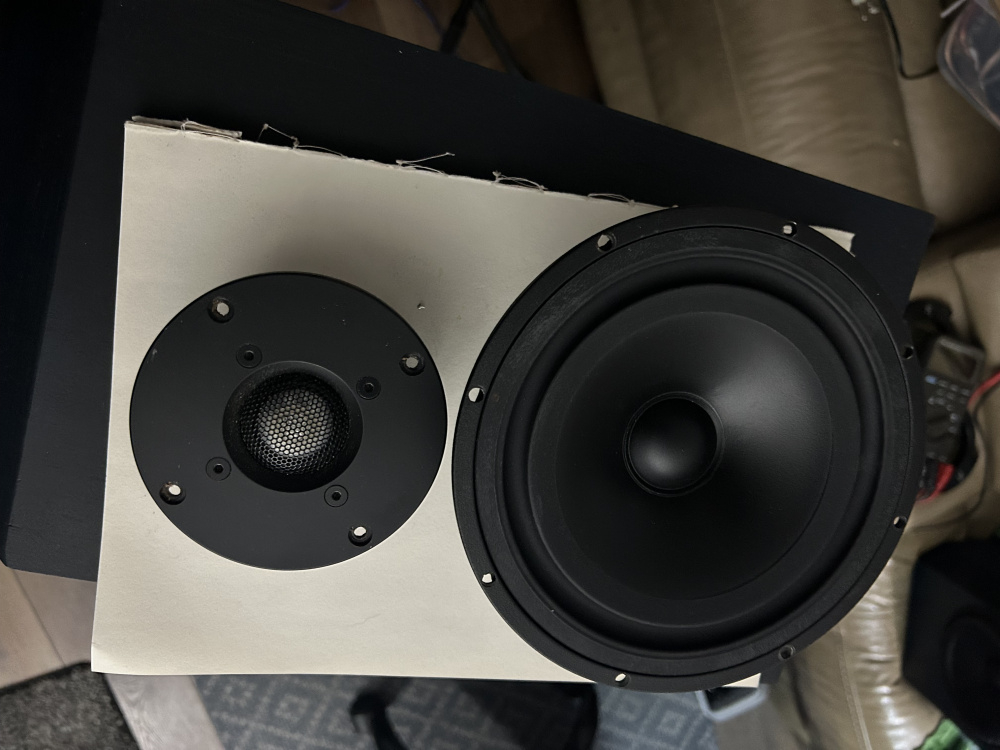

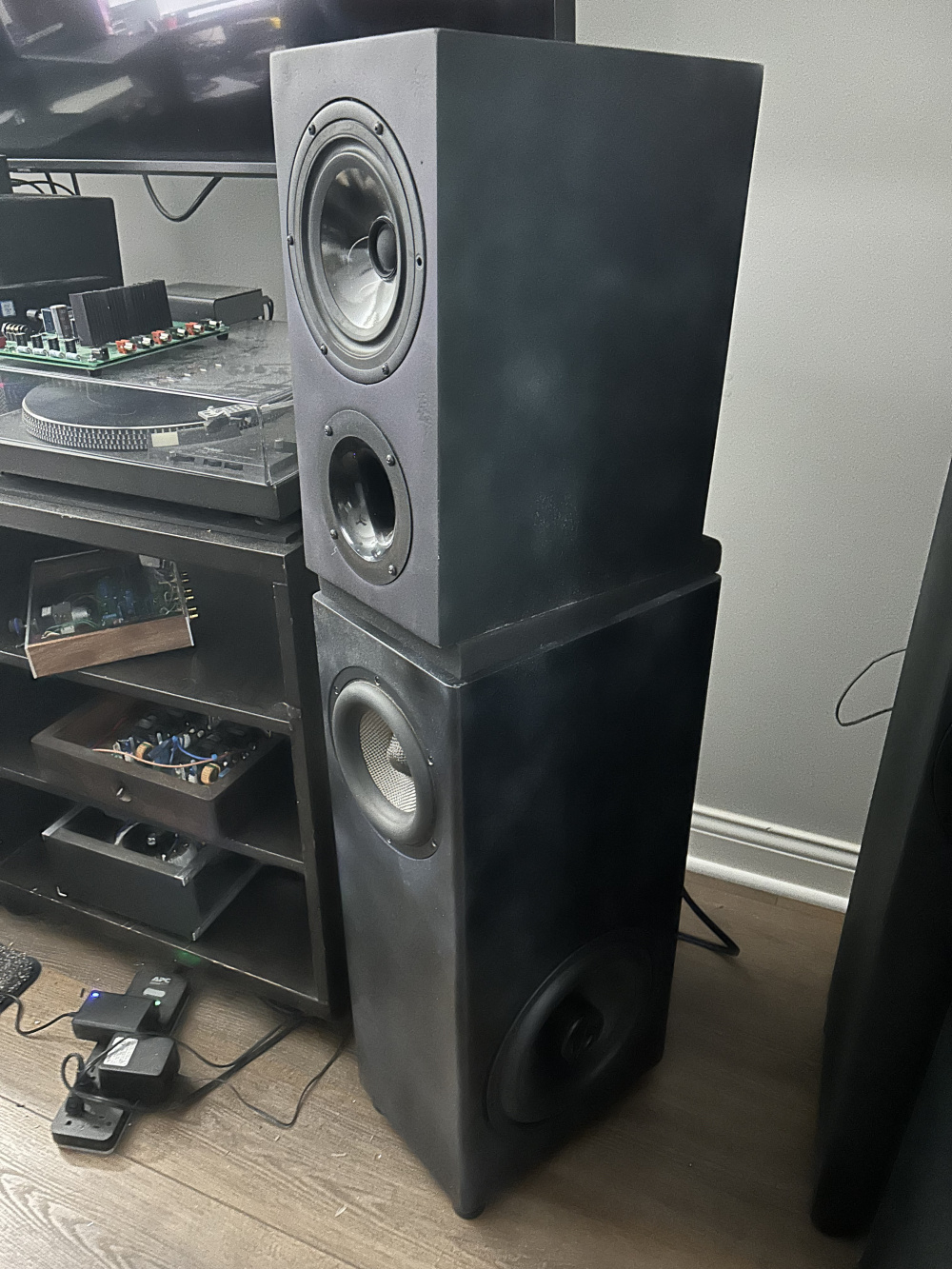







Comments
I don't think your Seas 3way would be turned away at SDC. You developed it, even if it is close to another design, it's still different.
InDIYana Event Website
That is assuming they are even paying that much attention.
Though not really eager to go to SDC, it's just 1.5hr drive for me. I should come out to one of the other events. Wanted to go to the CSS event but was tied up. Not up for the thematic challenge for Indy, still more in learning stage heh, though sure it still enlightening and fun experience.
Will see how xover comes out, do tend to like 2k ish point but imagine it can be pushed up higher if wanted to. Using seas's network for the Loki's where there is that scoop in middle, haven't bothered try diff network as maybe unload those when complete new Seas speakers. At least whole loki 'premium' kit was deep discount used.
Just remember, you don't have to participate in the challenge to attend InDIYana. You can be a spectator or bring something that does not comply with the theme.
InDIYana Event Website
The Seas 3 way project been valuable learning experience. I knew the application note was specific to the tiny box and as 2way. Trial and error of components after initial modeling in previous projects drive one nuts and frustration grows as even if you get the measured summed response, things just not sound pleasing as well as the tug of war with phase etc. Had saw insightful notes from Javad about how often the power response leads to nice sounding results that not capture by a just looking at a freq response.
Anyway... so got down to this crossover, where basically landed back at about the same network for tweeter and learned much about band pass gain for a driver used as a midrange. Also I'm somewhat ignoring the huge dip at 10.5k knowing some of that on axis nature of coax's and waveguides sometimes, not fully study that phenomenon yet. Still using an earlier revision of 6.8mh-100uf on the seas titan 7 driver, not shown in this pic, where was about a 300hz crossover point, I think (at least when take nearfield and apply Bagby diffraction effects). While bad habit reaction would be reduce the inductor and perhaps the cap... from past experiments with 2way bookshelf merge with bass bin sub, where apply 6db (cap) high pass that 3rd order/18db bass low pass seemed to sound best to me then.
So question is, understanding that acoustic slope may be 2nd or 3rd order, still wonder if using 3rd order on woofer, targeting 400-450hz point work better and or should just try pounding away at tuning 2nd order (L-C) for the bass woofer?
Notice many of Curt/Jim's designs also land at cap for high pass. Using 2nd order with inductor shunt keeps tanking impedance really low and sonically things sound very close to right now where need to correct my 300-350hz ish dip that observe with likely too low pass on woofer currently. When try pulling the mid down a little lower, it starts humping up bit much and would think the good quality titan woofer should be involved more anyway heh.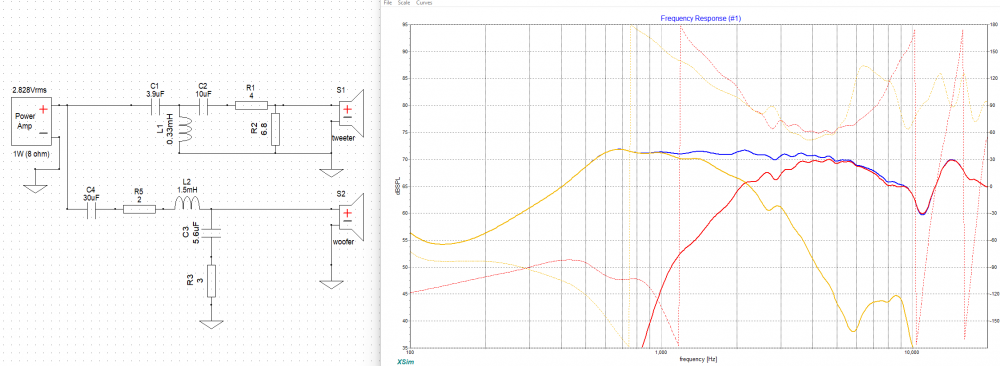
ignore db levels as my measurements were not at full power level, just relative to eachother. Listening perceptions are that levels lining up well with bass woofer currently.
Traw, it might be beneficial if you post raw measurements with information about how the measurements were taken.
Measure from about 3ft, though at not 1v level as I should so can compare apples to apples across all measurements. Also not doing much with off axis measurements, someday. I know make chuckle about bass level by ear, should expound to say more where limited to gating, stretch out impulse time to pick at general average level. I think ended up where put project aside to revisit later, adjusted the 2 ohm up 4 to take out some 700hz humping (below is after) when added the bass driver. Lighten the low pass cap and seems 300 hz upward looks ok based estimation that needed a 400-450 bass-mid xc, no dips or nulls that have seen before if things totally in left field. Original question was more around if electrical 6db high pass, is 18db inverted low pass for woofer better or to just use the woofers 'force' in 2nd order to blend. And all that stems from needing to experience (learn by failure), or if others have tidbits about acoustic slopes vs electrical to move toward best practice. I'm aware acoustic slope change mostly result of natural driver rolloff - but yall know it's easy to get lost with the interweb knowledge, lot of deciphering fact, their usefulness and opinion.
It looks like it will be midrange forward. You may need to notch the peek at 15k and broad notch at 5k to level the dip at 11k. Tweeter does not look easy to work with.
Yeah think to work with this need to learn more about off axis. I probably do need to further scoop the 1-5k (or saying the 500-2k) somehow, but like you guess the tweeter not friendly. Where for sonics want to go back to my sb 3 ways. It is making me think the L12 coax geared for a diff market segment rather than being good choice for 2 of the 3 way. I think the 1.8k blip from something that cannot easily fix. Early on tried a crossover design landing around 3.1k and sounded horrible despite getting flattish response, though aware the downward tilt tends to be most pleasing.
I also like a downward tilt but I think something like this would be better.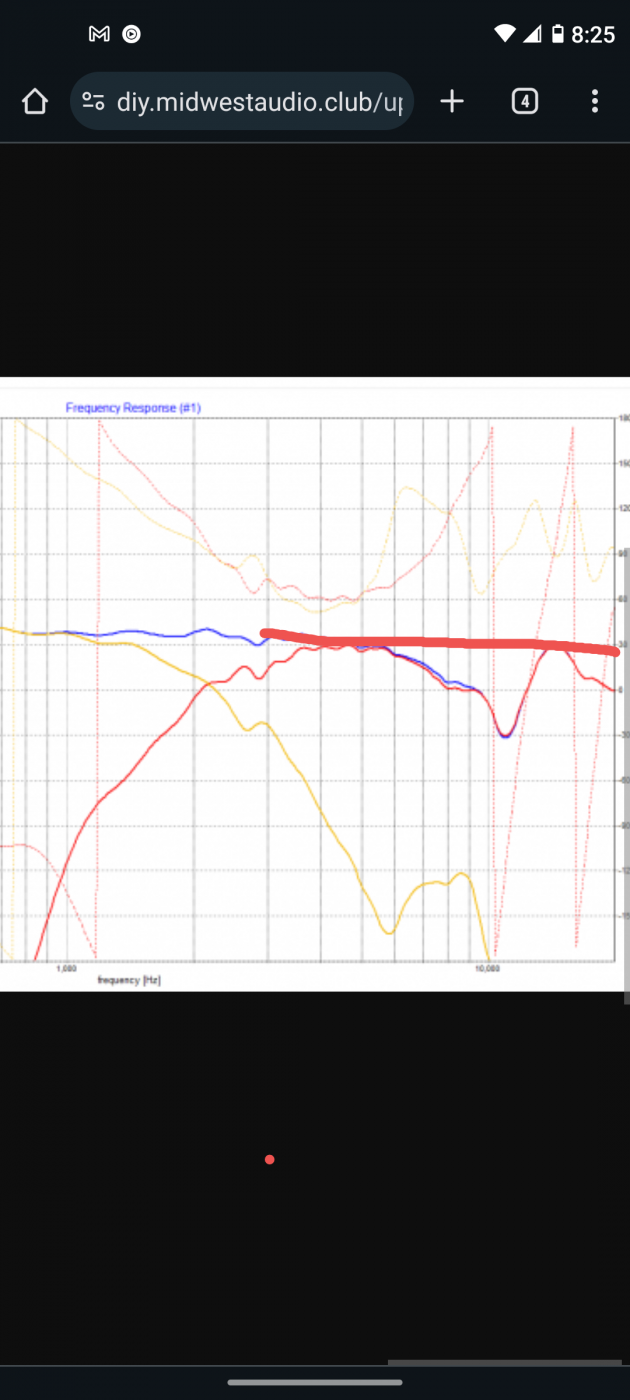
Simulated a LR4 as the drivers not bend nicely, cobbled together listening on single speaker but seems promising where need to build out the other one. Plus I was irked by the breakup interference at 8-9k. The 10.5k dip need to do some off axis to see how much it mutates. The 14.5k peak not too worried about as not sure i can even hear that at my age heh, and imagine could tinker with a notch if sounds bothersome, see if the dog gets offended. Still need to re gigger the woofer to mid crossover and shaping since think that xc bumped up from 400 to 500 roughly. Orange was response before in REW and bluish the new LR4 mid-tweet network.
Finally, think reached that done is done state, maybe some fine tuning tweeter level little with the shunt resistor. Got lucky with the bass driver integration level, crossover for that around 425Hz. Adjusted schematic tiny bit, got rid of the big shunt inductor on mid which helps keep impedance friendly. Will do an overall impedance sweep but not think the 8ohm bass driver (not on schematic but part of the gated measurement) drag it down much.
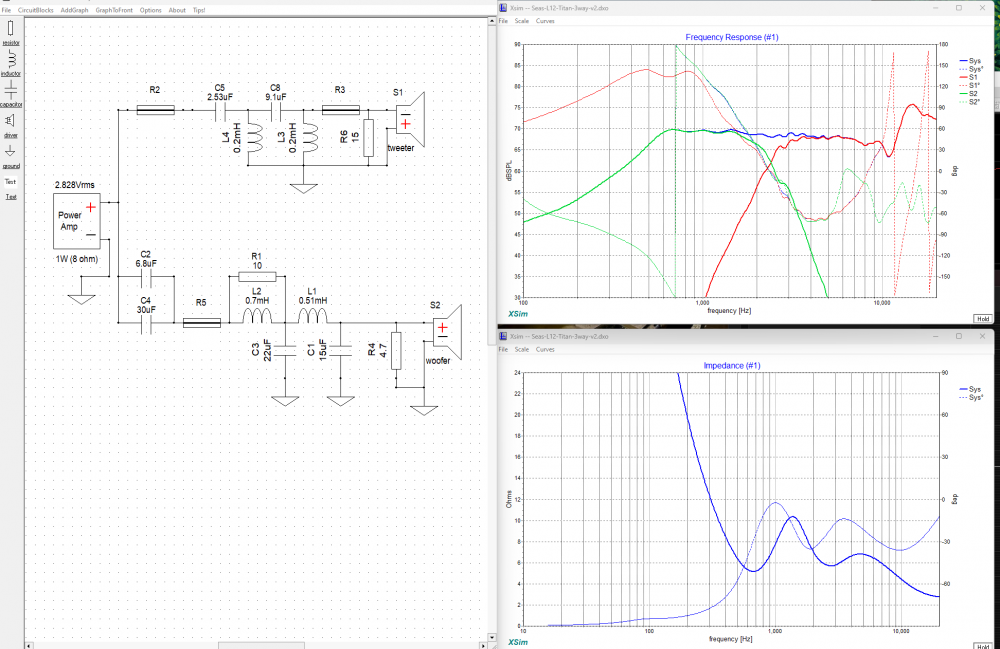
Definitely much better sounding now.
This is what I feel much better about, speaker sounds better, easier to simulate. Shout out to AE4audio for chiming in on my convoluted questions and curiosities here and on PETT. Also participate some on the various FB groups - there is so much more conversation these days as well as elevated group think.
The above efforts on the seas coax bass assist 3 way was discouraging me. Got it to the point where measurements looked 'good' to my naive eye but just didn't sound great or special in any way. Sounded ok but no where near the premium on the drivers involved. Learned the hard way about 3 way where cannot just slap a bass driver to a smooth looking 2 way at 300hz and call it a day.
That ~10k dip common to coax's, trying to "fix", I over tilted the tweeter response shallowing the dip and pushing the 15k spike further up. Made it look on measurements but it really sounded like tweeter involvement lacking, like i need to clean my ears out to hear better. So back to the drawing board.
Realized in recent past efforts, 3 ways which was committed to despite the warning of challenges, that bass to mid integration was poor. Had to learn more about vituixcad merger and frd blender so could incorporate more data into the modeling. Also along the way realized usb mic not capturing phase accurately. Switched to emm6 and motu2 - not compared differences, but the data fed into modeling seems to be working better now. Still more to refine on near field far field blending as well many more measurement techniques for analysis.
Anyway, so happy to see modeling reflecting measurements, or in the ballpark to make tweak-listen decisions. Posting pic of the reverse null model vs measurement and another pic for normal response
tinkering with 6k notch as some guitar gets little excited, and maybe just bring down tweeter about 1-2db
Also, in above pics rear mounted PR not accounted for in measurement, been trail n error there, meantioned on diff thread but seemed the lower tuning giving extended bass shelf was sounding better, especially if turn subs on and easy to tune so not localize sub but extension present.
Just a thought or 2, I would try a 0.1uF cap across one or both coils in the mid lowpass to nuke the upper breakup peak further. The woofer could also benefit from the same treatment to reduce its breakup peak further. For best results, -40dB is what to shoot for or better.
I see you are crossing the midrange in at about 700Hz and 2.5k. I also see you are comping the Fs of the midbass. Looking at the specs, it has a high magnitude, so I feel you are on the right track there. I do think that you are limiting its use to a filler driver arrangement though, and could likely get more bandwidth from it, say 500 to 3k. I know the metal cone likely gives pause higher, so it may be limited to 2.5k. I think the highpass coil could be closer to 4mH, and use an LC across the mid instead of LCR, and just nuke the Fs. 20-30uF seems about right for the highpass cap.
InDIYana Event Website
Thanks for the hints. Yeah I was growing frustrated with the L12 and the titan woofer is so articulate, where was like it was pleasing me more. Think early iterations tried 3k ish mid-tweet crossover but probably had too many other problems going on and think mention somewhere of a 2.1k distortion bump for the L12 woofer - but not see it and anything read online taken with grain of salt then involves thinking for self. Definitely has been a good learning project.
I did some tinkering in simulation land, might rig this up using 500 and 3.1k points. The series notch to sitting off to side of tweet flattens the 6k hump a little, not wired as would try at tweak listen time. The other notch was for the 1.3k hiccup - but sometimes those 1-2k quirks less offensive than something like a hot 3-4k. The 500hz woof-mid xo was giving me some phase fits, and that 12mh huge (maybe snap up frugal buyout 12mh from PE if validates). At least i have box of various <1uf caps from electronic diy endeavors. In previous iterations tried the single cap, 6db electrical approach but end up with lump down around 100hz where wondered if measurements accurately reflecting outcome since not merge and nearfield stuff in, it's in a ~3L sealed chamber. But I in previous listening tweaking, seemed the 2nd order electrical made mids touch clearer. I'm sure i'll have to fiddle with more as adjust padding, shifting phase stuff.
Turns out only needed the cap across 2nd inductor to tick mid breakup down. Also just using 6.5mh (PE buyout that had) for shunt L, no cap. But then simulated phase alignment didn't match up with measured so did brute force swapping cap for the woofer until reverse null looked better, down to 6.2mh-50uf, and normal measurement looked better too. While only listening on one speaker bass much improved, fuller - prob largely from the larger coil. Probably play more with the 2.5k vs 3k mid-tweet xo and build out other speaker for extended auditioning for couple days.
Not wanna create new thread, so figure if I just talk to myself on this thread I had out there and maybe someone comment heh.
Anyone recognize or familiar with these speakers?
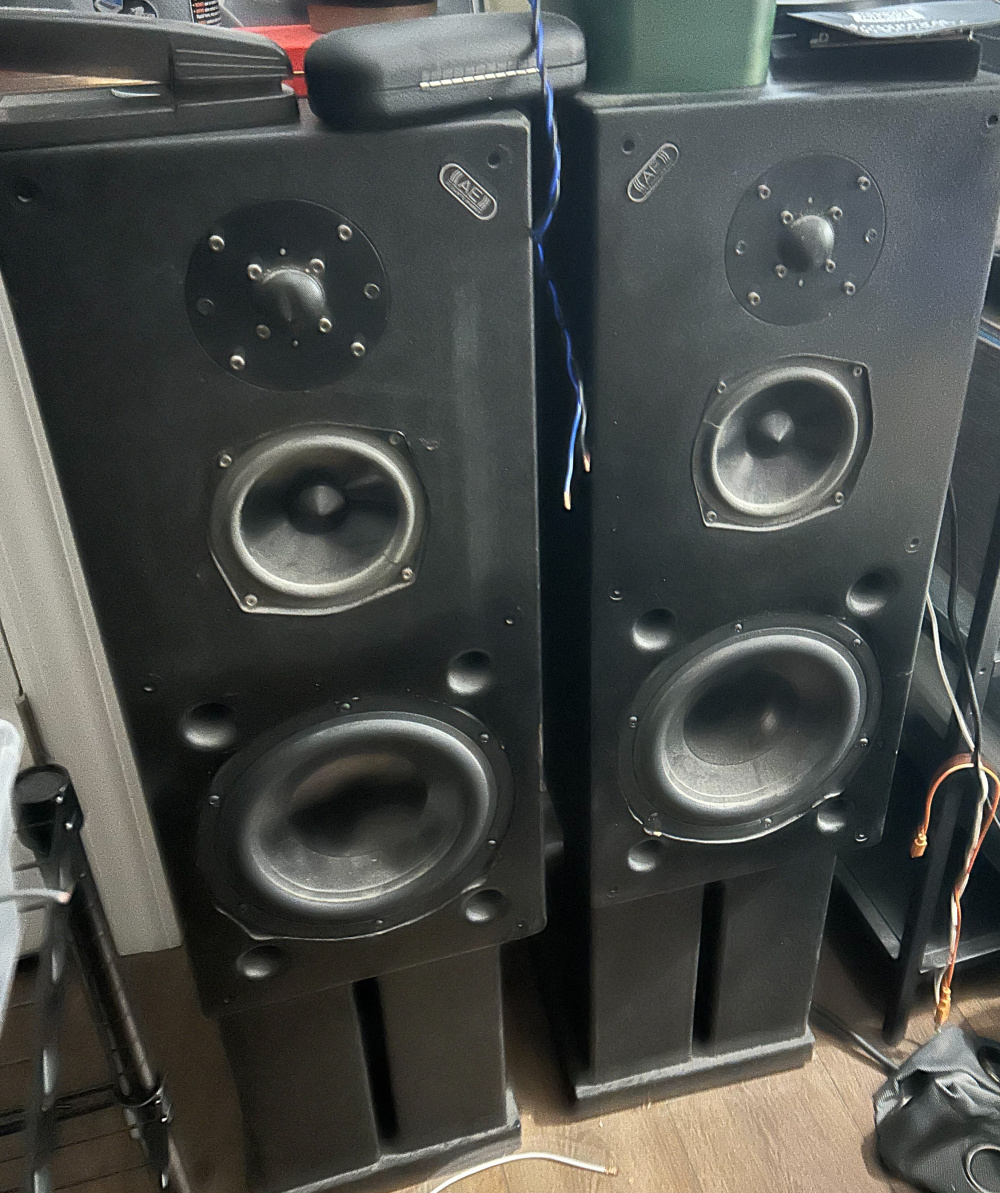
The tweeters look like LPG, if that gets you anywhere. I've never seen the speaker systems in question.
InDIYana Event Website
https://www.ebay.com/itm/325879193735?mkcid=16&mkevt=1&mkrid=711-127632-2357-0&ssspo=hDVJPfqzSwq&sssrc=4429486&ssuid=NtMdzbxQRTm&var=&widget_ver=artemis&media=COPY
Spendy!
I consider these my commercial reference speaker, Acoustic Energy AE3's. 2 way AE1's are better known, actually saw the AE1's in studio of that Beatles video song released last year. I bought them off Audiogon way back in late 2005 for 700 bucks, they are heavy as hell (~100lbs each), got bang up a bit in shipment. Originally released 1989 or so at 4K, loved them after diseased OCD gear swapping on agon (von schweikerts, NHT 2.9's, VMPS towers etc.). Few weeks in I smoked the bass driver's voice coil with Tool's Prison Sex, ug. Was impossible to find replacement woofer, manufacturer no help plus it had already been 15 years then. For long time used a Hivi M8n that worked ok after trying few others knowing would never be a perfect replacement, was more ignorant back then.
2019 bought the ScanSpeak 'Aerial' 8 inch buyouts which were ideal for 0.75-1cuft, ripped out the bass portion of xover and drove the bass active at 300hz 18db (the xover points 300 and 3000, 18db/24db respectively). Sound great but I like to tinker with amps and hard to get complete impression of amp's chops 300hz and above. The binding post in rear have all three legs of the crossover, guessing as they were targeted largely to studios where tri amping and could tweak levels - dunno. I tried to reverse engineer the xover schematic back in 2019 and was baffled. But think now I might try again since have dats now to measure the inductors. Also have correct foams if wanna replace the overlapped refoam job that Stereolab in CBus did back in 2006.
These things get crazy loud without breaking a sweat and very smooth, touch forward but I like that when not harsh, they made me 3 way lover (that sounds wrong heh). So maybe over summer or fall try to make the speaker whole again.
Question.... about ferro fluid. Did always notice the top end little rolled off when audio bug bit again (~2019), though will take measurements if/when take on that endeavor. Will a 30+ year old speaker's tweeter be suffering from ferrofluid dryout?
Oh, then I have heard of the name. Acoustic Energy are touted highly in lots of places. Bob Rappaport at Essence sells them currently.
As to FF, maybe you can remove it carefully and compensate the Fs in the new xover if dried out. The old LPG weren't difficult to take apart.
InDIYana Event Website
Harvested the E180's from thugs from Indy DIY into 30 tall +1.5 wheels, though mixed predictive for the 3" flared port. Dats tells me 36 hz though 10" long, make another at 12" and see where tuning is. The inner peak higher than lower one telling me not quite at resonant freq tuning. These much more efficient, have wired as 4||4 at each woofer then series, so 2+2 = 4 ish. Have very light poly fill in behind woofers to reduce backwaves(???), maybe remove and just put wall liner (wool/denim mat) in. While box is 1.65 cuft, tuning freq 36hz with 3" flared at 10" length - not seem right so have to narrow down where mismatch between simulation and actual measurements land.
Also... these NE180's are very nice (50 buck for the pair on ebay) and seas 29tdff tweets, while they say the waveguide uber shallow can still hear the effects, though also 2K xover point muddies the waters for analysis/comparison.
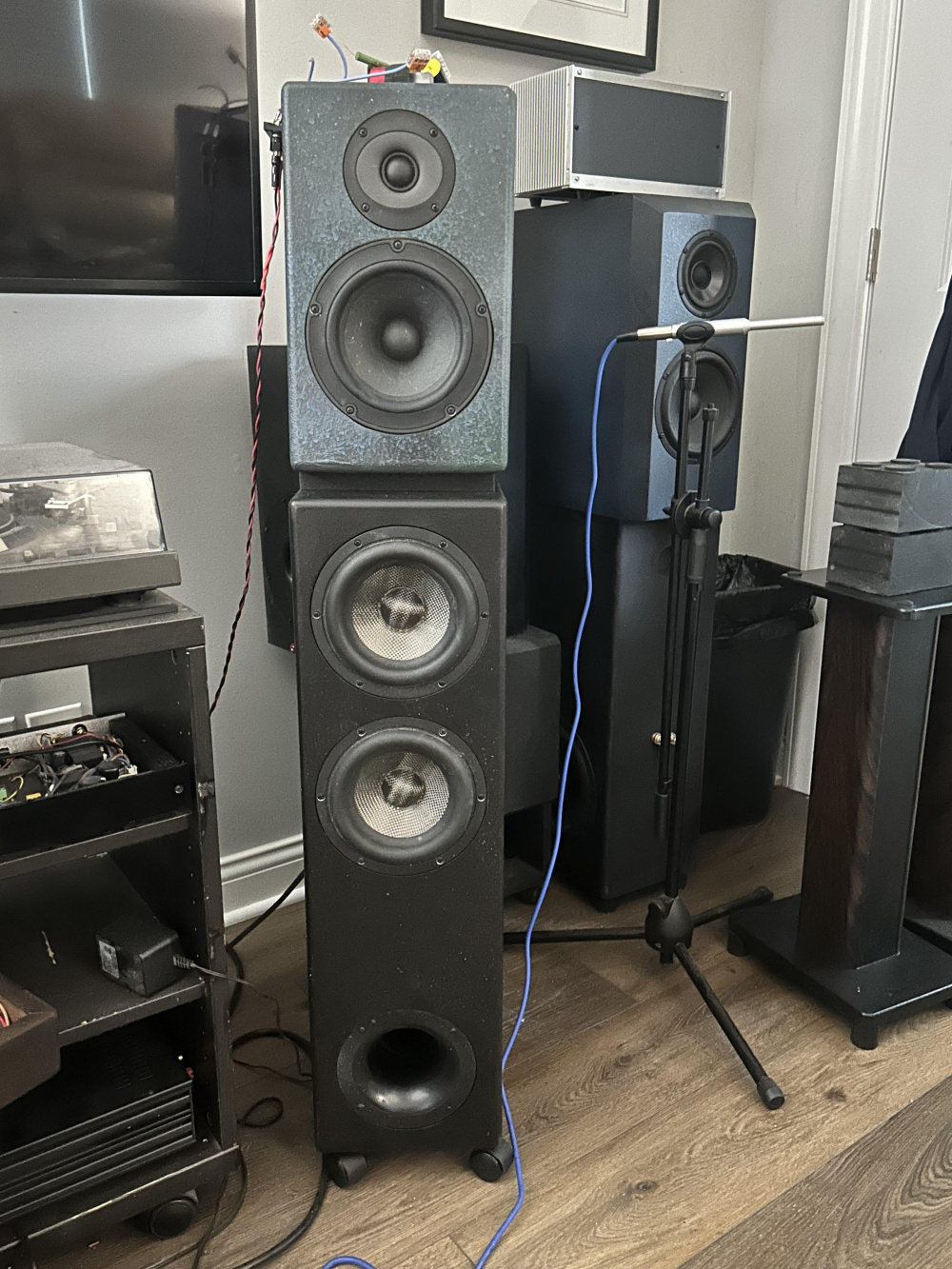
Now I'm burning out, plus really need to shift OCD efforts to getting physically healthier (err less fat)... Though put the wavecor WF146WA02 that had in the Indy project as mid to use, box had already been cutout for the 146 diameter woofer. Really like this woofer and surprising bass output in this 14L box tuned at 48Hz. Though wonder if anyone else feel like on 2 ways some woofers give up their voice if keep bumping the coil up for more bass/bsc but this thing just wanna keep singing. Though these tweets (snagged from tktran late last year) are almost like information overload, smooth and lot of detail, very clear.
That WF146WA02 looks like a great little driver on paper but what is this tweeter you say sounds so detailed?
It's a Seas Titan. I agree that they are just fantastic (once you have them matched or fixed, see my EMP/27TAC thread)!
InDIYana Event Website
That ^ doesn't get me anything relative in a web-search, Wolf.